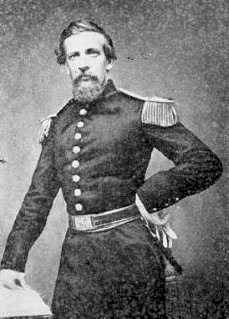|
The Rest of the Story: General John Bowen by For the past century Civil War historians have been perplexed over the death site of General John Bowen, one of the heroes of the Vicksburg Campaign. A recently found document has provided the final piece to the puzzle and opened the key to the past.
On July 12, 1863 an army ambulance left
Vicksburg en route to Raymond. The passenger and patient was Confederate
General John S. Bowen, a paroled prisoner of war who had fallen
desperately ill with dysentery, a bacterial illness that is often fatal.
General Bowen, a Missourian, was a
courageous and disciplined commander. During the Vicksburg Campaign, he
proved his leadership abilities on the battlefields of Grand Gulf, Port
Gibson and Champion Hill. For his efforts, he was commissioned major
general. In the eyes of his men, a finer commander could not be found.
During the first days of July, when it became apparent that Vicksburg
would fall, it was General John Bowen and Col. L. M. Montgomery who
worked with General Pemberton to help establish the terms of the
surrender. However, on the morning of the 4th of July, Bowen had become
conspicuously ill. Bowen's wife, Mary Kennerly Bowen, was
summoned from St. Louis but by the time she arrived the situation had
become extremely grave. Members of Bowen's staff decided to transport
him to Raymond where they hoped he could receive medical attention. On
July 6, during the excruciating heat of summer, the ambulance began the
long and arduous journey to Hinds County. Father John Bannon, Catholic
priest with the First Missouri Regiment, accompanied the general and his
wife on the journey. As the ambulance got under way, Bowen's
illness became progressively worse. It was apparent that he would never
make it to Raymond. On the morning of July 12, the ambulance took the
lower road between Edwards and Raymond [Mt. Moriah Road] and stopped for
help four miles from Edwards at the home of Mr. Morrison. Due to the
lack of servants, the overseer suggested they go two miles further down
the road to the home of the Walton family, also known as Valley Farm.
The Walton's home was located six miles from Raymond near a crossing at
Baker's Creek. Bowen's body was later exhumed from the
Walton's garden and re-interred in the cemetery at Bethesda Presbyterian
Church, two miles away. The unmarked grave remained obscured for
twenty-four years. In 1887, Mary Bowen returned to Mississippi to help
members of the Vicksburg Ladies Confederate Cemetery Association exhume
the body for re-interment in Vicksburg's Confederate Cemetery. Through the years, the story of Gen.
Bowen's death and burial in rural Hinds County was all but forgotten.
Except for descendants of the Walton family, who loved to reminisce
about the 'famous Confederate general' who had been buried in their
garden, stories and details of Bowen's death all but vanished. Around the turn of the century, the
Missouri Republican, a popular newspaper from St. Louis, reprinted an
article extracted from an 1860s Mississippi newspaper. The article,
recounting General Bowen's death in rural Hinds County, had originally
been published in the Hinds County Gazette. Recalling the event from
memory, the Gazette editor had written: "General Bowen was not
killed, as supposed, but died a natural death. He was taken ill with
flux either at Vicksburg or near that point, and rather than go into the
city and risk the chances of capture and ill treatment by the federal
forces, came into the country. He found no shelter at Edwards, and
stopped first at the place then owned by Mr. Farrar Morrison, four miles
from town, which was in charge of Mr. Joshua Stone, but owing to the
scarcity of servants, that gentleman advised him to go to Mrs. Walton's
two miles further on. This was about the 26th of June, 1863; on the 1st
of July, only three days before the fall of Vicksburg, he breathed his
last. His wife and two or three from the neighborhood were the only
persons present." The dates stated in the article were incorrect
but the directions to the Walton home provided the missing piece of the
puzzle needed to solve the mystery of General Bowen's place of death. General Bowen's family read and saved the
reprinted article, placing it in their scrapbook. Eventually, Bowen's
daughter donated all of her fathers' Civil War papers to the Missouri
Historical Commission, including the personal memoirs contained in the
scrapbook. Unknown to historians, who for over half a century had
searched for yet failed to find the home where Bowen had died, the
clipping from the Hinds County Gazette held the key. The final piece in
the puzzle, the discovery of the location of the Walton home, fell into
place in 2002, after the 1860s newspaper article was discovered in the
Manuscripts Division of the Missouri Archives. As Paul Harvey would say…. And now you
know the end of the story. General Bowen's ambulance never made it to
Raymond. It stopped six miles from its destination. In the company of
his wife and priest, as well as few neighbors in the area, the general
was laid to rest in a lovely garden where the fragrance of summer
flowers mingled in the air - and the sounds of fife and drum were but a
distant memory.
| ||||
|
© 1998 - 2002. All Rights Reserved. |

